How to Use Encrypted Model With OpenVINO
Deploying deep-learning capabilities to edge devices can present security challenges like ensuring inference integrity, or providing copyright protection of your deep-learning models. OpenVINO™ provides a simple method with a crypto algorithm to protect a model in the disk. Model encryption, decryption, and authentication are not provided by OpenVINO but can be implemented with third-party tools (i.e., OpenSSL). In this example, we use the AES-128-cbc algorithm in OpenSSL to demonstrate the model cryptography.
As you can see in the image below, there are two parts to the process:
- First is to encrypt your plain IR model into an encrypted model.
- The second part is to use the same password key and IV which was used for the encryption before to decrypt the model at the model loading runtime.
Step 1: Encrypt model
Make sure you install OpenSSL, for example in Ubuntu:
$ sudo apt install opensslThen use the command line to do model encryption by OpenSSL AES-128-CBC algorithm. In this simple example, I use the same password for Key and IV, it is hexadecimal of the string “openvino encrypt”. You can use some online str2hex tool to generate a hex representation of your string password.
$ openssl enc -aes-128-cbc -in openvino_model.xml -out openvino_model_enc.xml -K 6f70656e76696e6f20656e6372797074 -iv 6f70656e76696e6f20656e6372797074
$ openssl enc -aes-128-cbc -in openvino_model.bin -out openvino_model_enc.bin -K 6f70656e76696e6f20656e6372797074 -iv 6f70656e76696e6f20656e6372797074Step 2: Decrypt model
Here we provide the sample code to read the encrypted model into the buffer and decrypt it to plain model binary. Then read and compile the model.
#include <fstream>
#include <iostream>
#include <vector>
#include <cmath>
#include <cctype>
#include <string>
#include "openvino/runtime/core.hpp"
#include <openssl/aes.h>using namespace std;vector<unsigned char> aes_128_cbc_decrypt(
vector<unsigned char> &cipher,
std::vector<unsigned char> &key,
std::vector<unsigned char> iv) { AES_KEY ctx;
AES_set_decrypt_key(key.data(), 128, &ctx);
std::vector<uint8_t> plain;
//cipherLen = clearLen + 16 - (clearLen mod 16)
int plain_size = ceil(cipher.size()/16)*16; //make sure alloc buffer is enough to plain_size
plain.resize(plain_size);
std::cout << "AES_cbc_encrypt start:" << std::endl;
AES_cbc_encrypt(cipher.data(), plain.data(), plain.size(), &ctx, iv.data(), AES_DECRYPT);
std::cout << "AES_cbc_encrypt done" << std::endl;
return plain;
}void decrypt_file(std::ifstream & stream,
std::vector<unsigned char> & key,
std::vector<unsigned char> & iv,
std::vector<uint8_t> & result) {
std::vector<unsigned char> cipher((std::istreambuf_iterator<char>(stream)), std::istreambuf_iterator<char>());
std::cout << "aes_128_cbc_decrypt" << std::endl;
std::vector<unsigned char> decrypt_model = aes_128_cbc_decrypt(cipher, key, iv);
result = decrypt_model;}int main() {
std::string password="openvino encrypt"; //real app should save key to hex use hex2string to process
std::vector<unsigned char> key(password.begin(),password.end());
std::vector<unsigned char> iv(password.begin(),password.end());
std::vector<uint8_t> model_data, weights_data;
std::ifstream model_file("openvino_model_enc.xml",std::ios::in | std::ios::binary), weights_file("openvino_model_enc.bin",std::ios::in | std::ios::binary);
// Read model files and decrypt them into temporary memory block
std::cout << "decrypt file" << std::endl;
decrypt_file(model_file, key, iv, model_data); //key & iv is the same
decrypt_file(weights_file, key, iv, weights_data);
ov::Core core;
// Load model from temporary memory block
std::string str_model(model_data.begin(), model_data.end());
auto model = core.read_model(str_model,ov::Tensor(ov::element::u8, {weights_data.size()}, weights_data.data()));
ov::CompiledModel compiled_model=core.compile_model(model,"CPU");
std::cout << "compile success" << std::endl;
return 0;
}
This blog just provides an example of model encryption by OpenSSL. This method can only protect your model in the disk.
Reference:
- OpenVINO model protection: https://docs.openvino.ai/2023.1/openvino_docs_OV_UG_protecting_model_guide.html
- OpenSSL official website: https://www.openssl.org/
Notices & Disclaimers
Intel technologies may require enabled hardware, software, or service activation.
No product or component can be absolutely secure.
Your costs and results may vary.
© Intel Corporation. Intel, the Intel logo, and other Intel marks are trademarks of Intel Corporation or its subsidiaries. Other names and brands may be claimed as the property of others.
